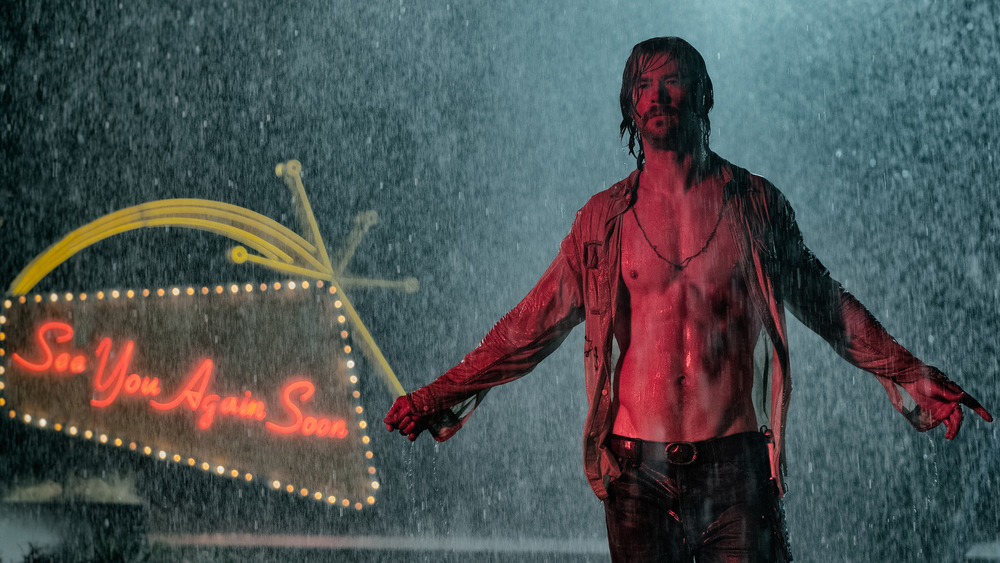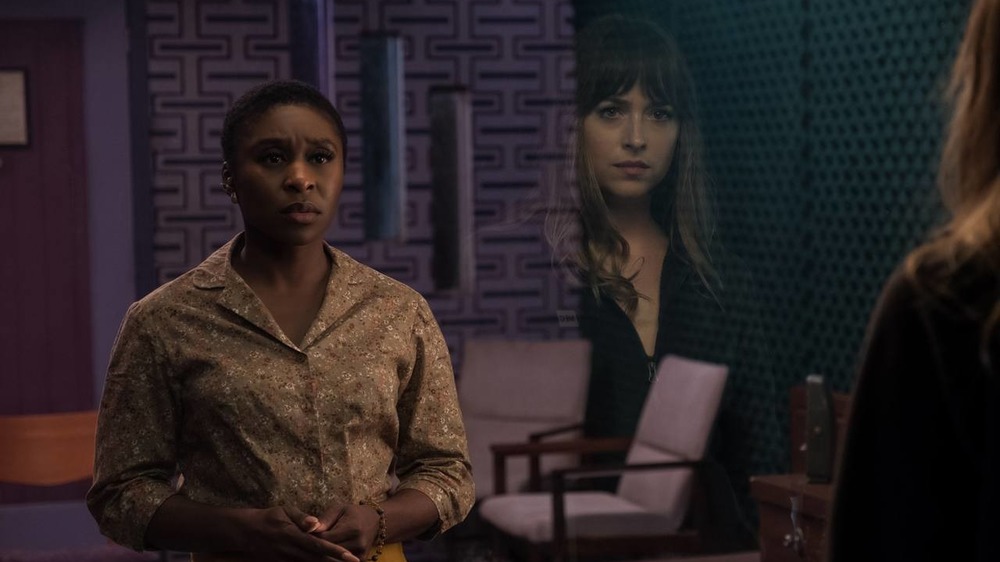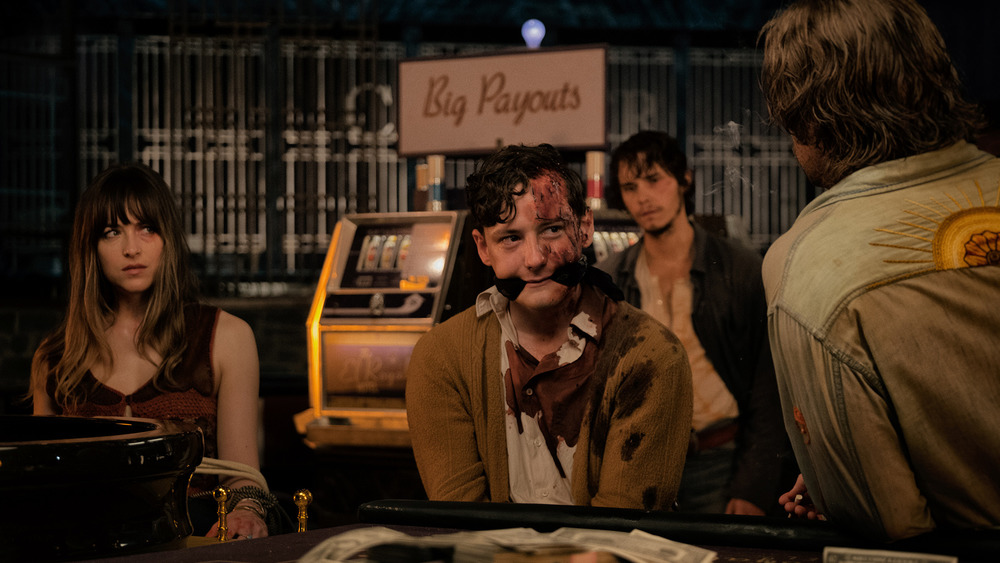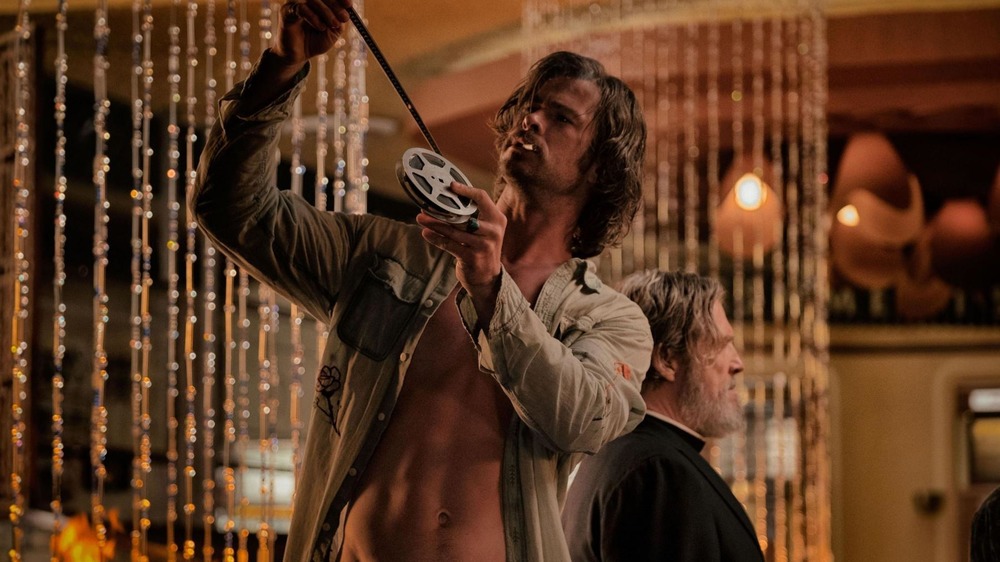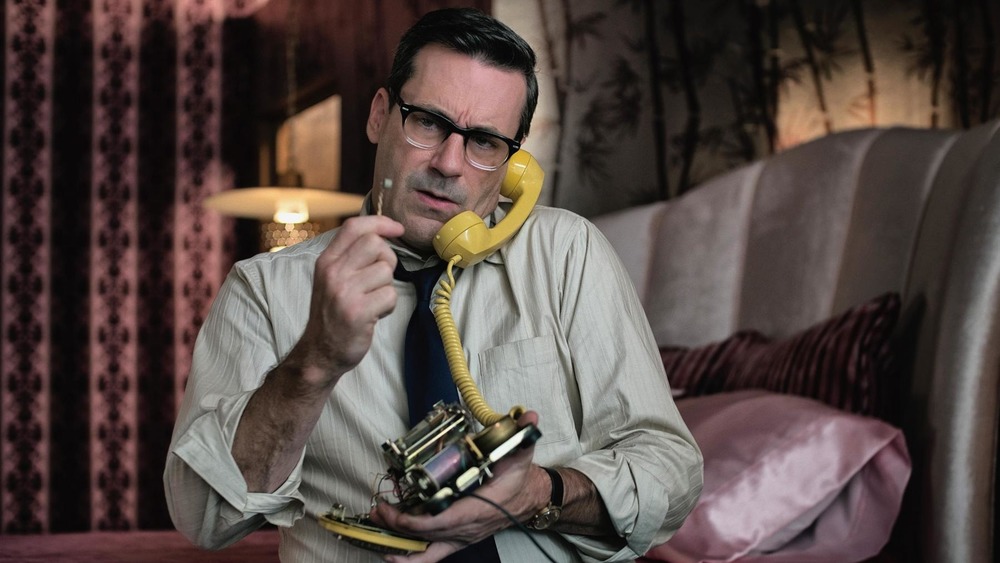Bad Times At The El Royale Ending Explained
Written and directed by Drew Goddard — the mind behind The Cabin in the Woods, Cloverfield, and The Martian – the 2018 film Bad Times at the El Royale is the story of seven strangers staying at a hotel on the border of Nevada and California on one fateful night in 1969. Although the film didn't make a lot at the box office, it did relatively well with critics and audiences, earning a 74% on Rotten Tomatoes, with a lot of praise going to the actors' performances.
Bad Times at the El Royale stars Jeff Bridges as Father Flynn — later revealed to be Dock O'Kelly, Cynthia Erivo as Darlene Sweet, Lewis Pullman as Miles Miller, and Jon Hamm as Laramie Seymour Sullivan, a.k.a. Special Agent Dwight Broadbeck. Filling out the cast are Dakota Johnson and Cailee Spaeny as the Summerspring sisters, Emily and Rose, and Chris Hemsworth as cult leader Billy Lee. Bad Times at the El Royale follows the seven main characters and the moral dilemmas that drive them to this fated location. As Emily tries to save her younger sister Rose from Billy's cult, O'Kelly works with Darlene to find the money he stole, and Broadbeck attempts to find the missing tape, the mysteries of the strange hotel, and its visitors, come to light.
Of course, that's just the start of Bad Times at the El Royale, and its many layers. So let's get into the film's ending and what it all means.
What is the meaning behind Bad Times at the El Royale?
In case it wasn't obvious from the split down the middle separating the Nevada half from the California half of the hotel, this movie is all about dualities and the characters' internal battle between "good" and "evil." But in Bad Times at the El Royale, nothing is that simple, and each character has to personally decide for themselves how far they are willing to go to get what they want. Unfortunately, Bad Times at the El Royale never gives you an answer, but that's the point. In an interview with Collider, Goddard explained, "I think we all sort of exist in shades of gray. [...] Even though there is a sort of polarity about the movie, everyone exists somewhere in between the two poles."
Just take a look at the characters. First off, we have Father Flynn, also known as O'Kelly. He comes to the hotel looking for the money left from a robbery a decade earlier, sparking a friendship with Darlene that causes him to question his life choices. Then there's Emily, who is at the hotel after kidnapping her younger sister Rose, a murderous woman who has fallen in deep with Billy Lee's cult. Out of everyone, the most morally just appear to be Darlene and Miles, but even they have their dark secrets. Miles, the hotel's heroin-addicted employee, is wracked with guilt over his time in the Vietnam War and his role in the hotel's dark activities, while Darlene fights to hold onto her values while trying to move up in the music industry.
Where do all the characters end up?
Thanks to Rose, cult leader Billy eventually arrives at the hotel with a handful of his followers. Holding everyone hostage, Billy plays a twisted game that results in Emily's death. Then he turns to O'Kelly and Darlene, asking them questions and preaching about destiny. A fight breaks out, and Miles is able to grab a gun and kill all the cult members, including Billy. Crying over his body, Rose is able to appeal to Miles' guilt and stabs him, before getting killed herself. In Miles' last moments, the young man asks O'Kelly to grant him forgiveness for his past sins and he does, despite the fact that he's not a real priest. This harmless lie relieves Miles of his guilt, allowing him a peaceful death.
The only people who manage to survive the El Royale with their life are O'Kelly and Darlene. Throughout the film, everyone's struggling to define right from wrong. Darlene and O'Kelly choose to let themselves live in the moral gray area, and they are the only ones to survive. The two leave with the money left from O'Kelly's robbery, burn the film and the hotel, and go on their merry way into Nevada. The final scene of the film shows Darlene sometime later, finally achieving her dream of being a well-known jazz singer at a nightclub. Before she begins her performance, she notices a familiar face in the audience — O'Kelly. They share a significant look and a smile, showing how their experience at the El Royale brought them to where and who they are now.
Who was in the film Miles saved?
One question Bad Times at the El Royale never answers is the identity of the subject in the blackmail film. The movie states that it's a white man with a lot of influence who had a very public death, someone every character recognizes on sight. It's also likely someone greatly admired by the public, as Miles, Darlene, and O'Kelly would all rather see it destroyed than be used to ruin that person's reputation.
While there are many people it could be, the most likely candidate is John F. Kennedy. The movie is set in 1969, six years after JFK's death in 1963, so his passing would definitely still be fresh in people's minds. Plus, Broadbent is ordered by J. Edgar Hoover to get the materials left at the hotel with great urgency, so it's clearly important to the government. While there are other people with the same level of public awareness and tragic deaths, JFK is the obvious choice. Considering his reputation with relationships, it's easy to believe that he might've met up with someone at a hotel like this.
Is Bad Times at the El Royale based on a true story?
While Bad Times at the El Royale is technically an original story, the hotel is based on the Cal Neva Lodge and Casino located on the borderline between the two states, which was open from 1926 to 2013. Similar to the El Royale, the Cal Neva Lodge was most successful between the years 1960 and 1963, when Frank Sinatra owned it. During this time, the hotel received many famous guests including many Rat Pack members, such as Dean Martin and Sammy Davis Jr. (via USA Today). It's even reported that Marilyn Monroe spent her last weekend here before her fatal overdose in Los Angeles in 1962.
In an interview with Screen Rant, director and writer Goddard cited Cal Neva Lodge as a specific reference for the film, mentioning that there were many conspiracy theories about the hotel having voyeuristic activities like the El Royale. The Cal Neva Lodge also had tunnels, first used to smuggle in alcohol during the Prohibition. Later on, Sinatra reportedly used them to help mob members and other celebrities move around the site without being seen. Along with that, there are many rumors connecting JFK and the whole Kennedy family to the hotel, and the person who owned it in the 50s, Bert "Wingy" Grober, was close friends with JFK's father, Joe Kennedy.
